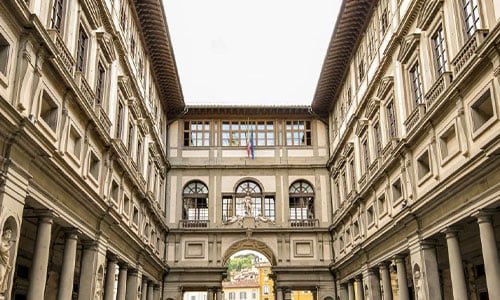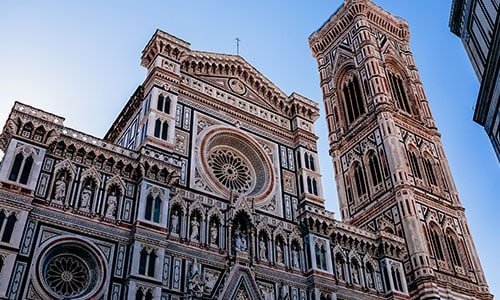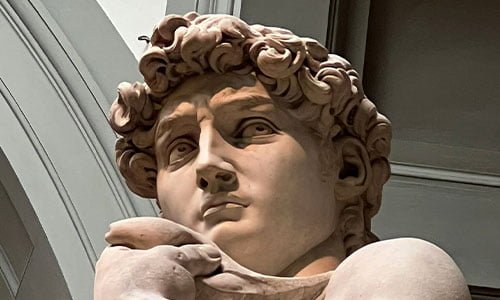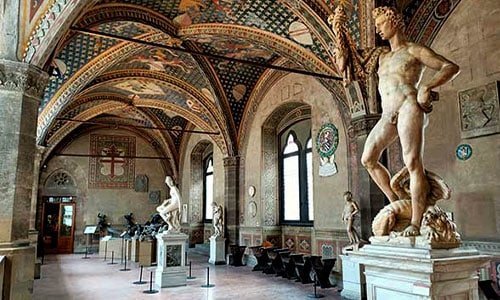free museums in florence
Free Museums in Florence (Always): What to See, from Churches to Villas
Not only do the Uffizi Gallery and the Accademia Gallery exist in Florence, but there are also some hidden gems you can discover for free all year round. Suppose you’re wondering what to see in the city without spending a euro. In that case, the list of free museums in Florence includes collections, Medici villas, unusual places, and numerous churches you can visit without buying a ticket.
In many cases, these offer great alternatives to explore in tranquility, away from the crowds of the most famous monuments.

Always Free Museums in Florence
It’s not just on the first Sunday of the month; throughout the year, a few museums and art venues in Florence are always free. Just a few steps from Piazza Duomo, you can enter an eighteenth-century residence adorned with frescoes, art collections, a ballroom, and an elegant staircase. Casa Martelli (located at Via Zannetti 8) served as the noble family’s residence for centuries. Inside this fascinating palace is a collection of seventeenth- and eighteenth-century artworks, including Piero di Cosimo’s “Adoration of the Child,” Beccafumi’s two wedding panels, and paintings by Luca Giordano and Salvator Rosa.
Casa Martelli is open on Saturday mornings with guided tours every hour from 9 am to 12 pm for groups of up to 10 people, lasting approximately 45 minutes.
As you stroll to the Oltrarno district, you’ll discover one of Florence’s hidden and lesser-known places, untouched by mass tourism, which is also one of the city’s free museums. Next to Torre San Niccolò, an elegant building on Lungarno Serristori, you’ll find Casa Siviero, once the home of an “007 of art.” It consists of small, captivating spaces that tell a fascinating story.
Rodolfo Siviero, a secret agent who saved many Italian masterpieces from the hands of the Germans during World War II, donated his private collection of ancient works, as well as paintings and drawings by his friends Pietro Annigoni and Giorgio de Chirico, to the Tuscan Region. Visitors can explore the rooms on the ground floor on Saturdays from 10 am to 6 pm, Sundays and Mondays from 10 am to 1 pm, while reservations are required on other days (only for small groups, via email at casasiviero@regione.toscana.it).
More About free museums in florence
Although it is not classified as a museum, this destination is worth mentioning among the unusual places to visit in Florence for free. It is one of the oldest pharmacies in the world, established in the thirteenth century by the Dominican friars from the nearby convent and now a shop famous for its beauty products. We refer to the Officina Profumo Farmaceutica di Santa Maria Novella (located at Via della Scala 16).
Among the nineteenth-century frescoed rooms, you’ll find the former chapel (now a salesroom) and the ancient apothecary overlooking the large cloister of the former convent of Santa Maria Novella. The workshop is open from Monday to Sunday, from 9:00 am to 8:00 pm.
Free Churches to Visit in Florence
The churches and their masterpieces: here’s what to see for free in Florence and the classic museums. For example, there’s no entrance fee to enter the Florence Cathedral and admire the interior of the Santa Maria del Fiore Cathedral (although during peak times, expect a long wait in line). However, you must purchase a ticket to access Brunelleschi’s Dome, Giotto’s Bell Tower, and the Baptistery.

Not far away, there’s free entry to the church of Santa Trinita (near Via Tornabuoni), with the Strozzi Chapel designed by Lorenzo Ghiberti. Further towards Piazza San Marco, you’ll find the Basilica della Santissima Annunziata, the city’s main Marian sanctuary. Notable features include the Baroque interior decoration and a tempietto by Michelozzo housing the trecento image of the Annunciation, which has always been highly revered.
A detached fresco by Botticelli (St. Augustine in His Study) and Ghirlandaio’s St. Jerome in His Study are the two symbolic works in the Church of Ognissanti, located between Santa Maria Novella and the Lungarno Vespucci. Founded in the mid-thirteenth century, it housed Giotto’s Maestà (now at the Uffizi) in the past. And if you look closely, you’ll even find the tomb of Sandro Botticelli. Crossing the river to the heart of the Oltrarno, you can enter the Basilica of Santo Spirito for free.
Filippo Brunelleschi designed it, which overlooks one of the most lively squares frequented by the Florentines. For €2, you can expand your visit to include the sacristy, which houses a wooden crucifix by a young Michelangelo, the cloister, and the refectory with Bernardino Poccetti’s frescoes of the Last Supper. Our tour of the free churches to visit in Florence takes us to the “roof” of the city, above Piazzale Michelangelo, where we find San Miniato al Monte, an abbey with over a thousand years of history.
It is one of the finest examples of Florentine Romanesque architecture and offers a unique panorama, especially at sunset. The chapel of the crucifix is by Michelozzo, and in the sacristy, you can admire the frescoes by Spinello Aretino. The crypt dating back to the eleventh century and the elevated presbytery is also worth seeing.
Last Suppers and Cloisters to Visit for Free
In addition to the free museums and churches, a myriad of art treasures are always free to enter: the numerous Last Suppers in Florence located between the city center and the outskirts, which preserve evocative frescoes. Generally, they are less crowded by tourists.
The Last Supper at Sant’Apollonia (Via XVII Aprile 1, not far from Piazza San Marco) houses the work Andrea del Castagno created in the mid-15th century for the ancient Benedictine monastery. In the same area, you’ll find the Chiostro dello Scalzo (Via Cavour 69), which was formerly the atrium of the Chapel of the Company of Disciplined of St. John the Baptist, frescoed at different times by Andrea del Sarto.
Another masterpiece by Andrea del Sarto is located outside the center of Florence, in the Campo di Marte area: the Last Supper at San Salvi (Via di San Salvi 16) is part of a free museum that occupies a prominent position of the ancient Vall.
Ambrosian convent. Temporarily closed are the Last Supper at the Foligno (Via Faenza 40) with the fresco by Pietro Perugino and the Last Supper at Ognissanti with Domenico del Ghirlandaio’s depiction. The opening hours of the Last Suppers in Florence may vary, so we recommend checking the Regional Museum Directorate of Tuscany website.
Medici Villas and Historic Residences with Free Entry
Moving beyond the city center, on the hills overlooking the plain of Florence, you’ll come across a small constellation of historic villas, residences, and museums open to the public for free. In the Castello area, in the northwest outskirts, you’ll find the Medici Villa della Petraia (Via della Petraia 40), which during Florence’s time as the capital, was also the residence of “Bella Rosin,” the lover and later wife of Vittorio Emanuele II.
The courtyard, covered in the 19th century, is adorned with 16th and 17th-century frescoes. Originally a fortified building, it became a grand ducal residence overlooking a terraced garden. Today’s furnishings date back to the second half of the 19th century.

A little further down is Villa Corsini (Via della Petraia 27), with a structure that blends Renaissance and Baroque styles and boasts an archaeological collection of sculptures. Nearby, you can freely visit the garden of Villa di Castello, designed in 1538 according to the principles of Leon Battista Alberti, featuring statues, pathways, fountains, and the evocative Grotta degli Animali.
The opening hours of the Medici villas may vary and are communicated on the website of the Regional Museum Directorate of Tuscany. Also in the same area is Villa la Quiete (Via di Boldrone 2), which is open only during specific periods of the year for free guided tours of the rooms and the painting collection (details on the website of the museum system of the University of Florence).
Inside, you’ll find works resulting from centuries of history: the building was owned by Condottieri, the Medici family, the House of Lorraine, and it was also a country retreat for the religious congregation of the Montalve, as well as the residence of Anna Maria Luisa de Medici, the Electress Palatine.
What to See for Free in Florence: Museums, Churches, and Villas to Visit
Here’s a summary of what you can see for free in Florence:
- Museum of Casa Martelli (Via Zannetti 8)
- Museum of Casa Siviero (Lungarno Serristori, 1/3)
- Officina Profumo-Farmaceutica di Santa Maria Novella (Via della Scala 16)
- Florence Cathedral
- Basilica of Santa Trinita (Piazza Santa Trinita)
- Basilica della Santissima Annunziata (Piazza Santissima Annunziata)
- Church of San Salvatore in Ognissanti (Via Borgo Ognissanti 42)
- Church of Santo Spirito (Piazza Santo Spirito)
- San Miniato al Monte (Via delle Porte Sante 34)
- Last Supper at Sant’Apollonia (Via Ventisette Aprile 1)
- Chiostro dello Scalzo (Via Cavour 69)
- Last Supper at San Salvi (Via di San Salvi 16)
- Last Supper at Foligno (Via Faenza 40) temporarily closed
- Last Supper at Ognissanti (Via Borgo Ognissanti 42) temporarily closed
- Villa della Petraia (Via della Petraia 40)
- Villa Corsini (Via della Petraia 38)
- Garden of Villa di Castello (Via di Castello 44/46)
- Villa la Quiete (Via di Boldrone 2 – by appointment)



